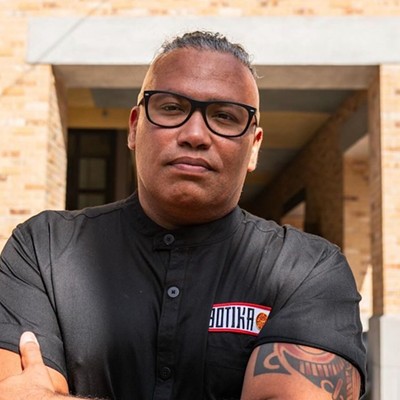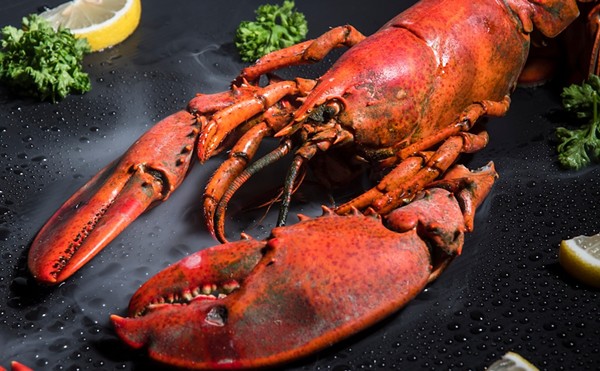For example, the “Night in Sevilla” at the Hotel Contessa featured tapas and other Spanish fare by Las Ramblas chef Derek Fontenot. An assortment of cheeses, marinated olives, tomatoes, and grilled artichokes wrapped in cured ham adorned a central table. Waiters passed beautiful grilled shrimp and shot glasses of lovely gazpacho. There was paella, and an exquisite pork loin stuffed with chorizo, goat cheese, and herbed bread crumbs. But the star of the evening was the humble Piquillo pepper — roasted, smoky yet fruity, and quintessentially Spanish — stuffed with shredded chorizo, thyme, parsley, and goat cheese, tinged with pimentón, Spanish paprika. If this little gem isn’t on the regular menu, it should be.
As a gin-martini purist, I was skeptical of the Osborne “Finotini” — a martini glass swirled with dry Vermouth and filled with chilled dry sherry and an olive — but it was fairly respectful of the excellent Fino it was made with. There were also red wines — notably the Solaz Tempranillo/Cabernet, the Montecillo Reserva and the Montecillo Crianza (my personal favorite). It was an intimate crowd, so conversations started easily — about the food, the music, the wine and life in general. There’s a certain camaraderie that tends to develop around food, and by night’s end we sat and enjoyed the company of new friends.
As a general rule, the food and wine at this festival are always good, and sometimes phenomenal. The formal dinners showcase our local chefs and restaurants, usually in conjunction with international winemakers and culinary experts. It’s the seminars, though, that offer the real learning experiences.
For neophytes, having a defined set of flavors to explore, guided by people with an intimate knowledge of their subjects, is an excellent introduction to fine wine and cuisine. The caliber of presenters makes the festival equally valuable for aficionados who want to refine their palate. The seminars typically present intelligent, sophisticated information in accessible, unpretentious terms that focus on the sensory experience. Which, when you get right down to it, is what it’s all about anyway.
For years I’ve kept a mental list of Inherently Good Things (IGT for short). It’s a highly subjective assortment of things — some tangible, like artichokes and massages; others ephemeral, like music and laughter — that I associate with joy, happiness and inner peace. Security for some people means a regular paycheck, an IRA, and health benefits. For me, insurance is a good stockpile of wine and olive oil. Suffice it to say that I was in good company at the seminars I attended.
Full days of the festival require a sort of culinary endurance, but it’s well worth the effort. My Saturday started at 10:30 a.m. with a glass of cava at the “Olive Oil, Wine & Spanish Cheese” seminar at the La Mansion, hosted by guest author Janet Mendel and Spanish culinary expert Gerry Dawes. Also on hand was Carlos Pons, representing Festival partner Carbonell Olive Oil specifically, but serving equally well as ambassador for Spanish olive oils in general.
Mendel and Pons provided an excellent overview of the primary olive growing regions of Spain, the types of olives used, and their various flavor characteristics. We tasted 7 oils, including varietals like arbequina, piqual, cornicabra, and hojiblanca. Some were mild, some acidic, and some extremely fruity with a pleasantly bitter finish. Getting back to that “inherently good” concept, imagine if you will seven elegant, minimal white bowls of glistening, golden-green oil, into which one dips small squares of absorbent, fragrant, fresh-baked bread to explore the complexities. It was pure bliss. But then it got better.
I know a little about Spanish cheeses, and many of them are on my IGT list. Spanish gastronomy expert Gerry “Mr. Spain” Dawes knows a lot. He also has access to the some of the finest artisanal Spanish cheeses available, which he shared with seminar participants. He also knows how to pair those amazing cheeses with remarkably compatible Spanish wines, creating a third level of taste sensation beyond the two individual components. He served tart, citrus whites with mild Tetilla and sharp Mogent Formatge de Cabra. We tasted exceptional examples of Manchego, Idiazabal and Mahón, paired with equally exceptional reds. I was introduced to a Catalan Pyranees cow’s milk cheese called Ceretà Seu d’Urgell, and a remarkably creamy, sharp, wonderful blue Valdeón, which was stunningly paired with an exquisite rosé, Prado Rey Rosado. Seven wines for seven cheeses, each a glory to behold.
After a two-hour recuperation phase, I headed to Luciano at the Strand for a seminar on “Old World Wines and Their Texas Counterparts”, where it became abundantly clear that some of our Texas wines have achieved a level of sophistication and character that hold their own against well-established Old World vintages. Notably good comparisons were the Llano Estacado ’04 Reserva and Drouhin ’04 Chardonnays, and the Torres ’01 Mas La Plana and Becker Vineyards ’02 and ’04 Cabernet Sauvignons. Aside from tasting 11 fantastic wines, sharing the experience and focused discussion with winemakers, experts, connoisseurs and innocents alike was both enlightening and enjoyable.
The day ended with the Grand Tasting — a chaotic, rambling, free-for-all of an event that offers a less formal sampling of regional fare. With more than 40 restaurants and close to 200 wines, there’s no shortage of good food, ranging from elaborate to elemental. It’s kind of a zoo, really, but it’s a hell of a lot of fun and well worth the $60 ticket. The more formal events can get pricey, but the seminars are a reasonably good bargain considering the quality of expertise, attention, and culinary product.
The Food From La Mancha
On the roster of luminaries at the New World Wine and Food Festival was cookbook author Janet Mendel, an American journalist who first set foot on Spanish soil 40 years ago intending to live abroad for a couple of years. She’s been there ever since, and has become one of the leading writers on Spanish cuisine. Mendel’s participation in the festival came on the heels of the May publication of her seventh book, Cooking From the Heart of Spain — the Food of La Mancha.
Mendel began her food-writing career with a monthly column on Spanish cuisine in Spain’s English-language magazine Lookout, which she did for 30 years. She began collecting recipes almost as soon as she landed in Spain, many of which appear in her first book, Cooking in Spain, published in 1987. Since then, her book Traditional Spanish Cooking has won Britain’s André Simon Award, and My Kitchen in Spain is a personal treasury of Mendel’s culinary adventures in her adopted country.
But the native of Decatur, Illinois, says she wasn’t much of a cook, or even particularly knowledgeable about food, when she arrived in Spain in the mid-1960s. In fact, she didn’t know much about Spain.
Her story begins with a provocative “I met a guy in a bar in New York.” She and her husband at the time, also a journalist, wanted to spend a year or two overseas. “I heard this man speaking in Spanish to some musicians at a bar, and I was trying to understand what they were saying. He invited us to join the conversation and the drunker he got, the more he talked about this village he came from. We wrote the name down and decided to give it a try.” They hopped on a freighter to Casablanca, a train to Tangiers, and a ferry across the Strait of Gibralter, landing in the plaza of a little town on the Costa del Sol in Malaga, with no plans in particular. She still lives in the town of Mijas, in a house set in a small olive grove.
The journalistic instincts that first guided her through seasonal food markets developed into a lifelong passion for the food and culture Spain, and got her into the kitchens and recipe books of both housewives and chefs.
The new book, Cooking From the Heart of Spain, deals with the regional cuisine of Castilla-La Mancha, the arid upland plateau in central Spain, and the land of Don Quixote. It’s also the region that produces some of the most recognizably Spanish products, such as saffron, Serrano ham, and Manchego cheese. Mendel acknowledges the landscape and history of the region, as well as the culinary seasons, in her well-researched text. Like the food it describes, the book has a simple elegance, with logically organized and easy to follow recipes.
Substantial sections on lamb, soups, and stews are particularly gratifying, as are her notes on seasonal vegetables. La Mancha is one of the main wine regions of Spain, and Mendel offers a good overview. There’s also an unusually comprehensive section on desserts, including a range of elegant ice creams, cookies, pastries, and the how-to on sweets generally purchased from specialty shops. Like all of Mendel’s books, it’s an excellent guide for those who want to cook and eat in authentic Spanish style, laid out in plain English.














